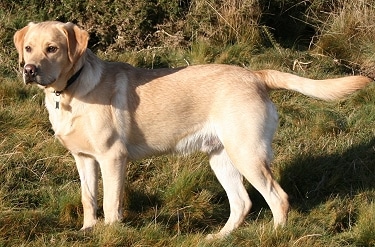
Although the Labrador Retriever as it is known today was developed in Britain, originated from dogs found along the East coast of Canada. These dogs had been known variously as the Black Water Dog, the Lesser Newfoundland, or the St John’s Dog; they were descendants of dogs taken there by explorers, settlers and fishing crews.
The dogs, found to have excellent hunting and fishing abilities, were brought to England early in the 1800’s where their “modern” development carried on. Crossed with other local sporting breeds, the strong and sturdy Labrador Retriever became, and continues to be, England’s most popular gundog. The Labrador Retriever or simply Lab for short excels in obedience and field trials, needs plenty of outdoor exercise and especially enjoys swimming.
Height: The height of a Labrador Retriever is 22.5 – 24.5″ (57.2 – 57.2cm) for dogs, 21.5 – 23.5″ (54.6 – 54.6cm) for bitches.
Weight: The weight for a Labrador Retriever is 60 – 75 lbs (26.8 – 26.8 kg) for dogs, 55 – 70 lbs (24.6 – 24.6 kg) for bitches.
Coat Type: The Labrador Retriever’s dense coat should be smooth and feel hard. The solid body color varies from black, to chocolate, to yellow (light cream color to fox red). The coat is easily cared for with regular brushing with a slicker type brush.
Temperament: The Labrador Retriever’s easy-going and friendly manner make him an excellent addition to families with children. The Labrador Retriever is easy to train and, by nature, is a true sporting dog. Labs love swimming and will play fetch in the water for as long as you will!
Health Problems: Labrador Retrievers are susceptible to hip dysplasia and all breeding stock should be x-rayed and certified clear. They are also at risk for several eye problems including progressive retinal atrophy (PRA), cataracts and retinal dysplasia, therefore all breeding stock should be examined annually. Other problems are: skin allergies and problems such as Acral Lick Dermatitis (lick granuloma), thyroid, and epilepsy, the latter being highly suspected to have a genetic component. On the whole though Labrador Retrievers are generally very healthy dogs.
Special Interest: Besides being the most popular gundog in Britain, the Labrador is the most popular dog in the USA and in Canada, topping registration charts in both countries. The Labrador has gained world-wide recognition as a good police and war dog, and also makes an excellent seeing-eye dog for the blind.
• A Labrador Retriever worked as a guide dog in Tel Aviv for 14 1/2 years.
• President Bill Clinton had a chocolate Labrador Retriever named Buddy.
Classifications:
AKC: Group 1 – Sporting Dogs
ANKC: Group 3 – Gundogs
CKC: Group 1 – Sporting Dogs
FCI: Group 8 Section 1 Retrievers
KC: Sporting – Gundog Group
NZKC: Gundog
UKC: Gun Dog
 Kennel.com – Complete Guide to Dogs The Dog Lovers Guide
Kennel.com – Complete Guide to Dogs The Dog Lovers Guide
 Your Labrador Retriever Puppy
Your Labrador Retriever Puppy